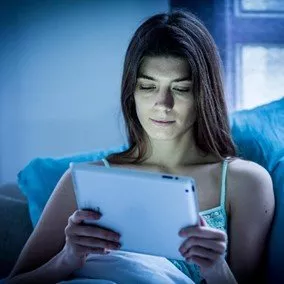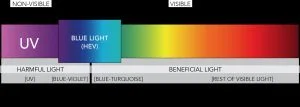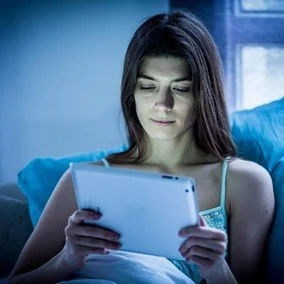Light is made up of many different colors. When you look at the colors of the rainbow in order, they range from longer wavelengths with lower energy on the red end of the spectrum to shorter wavelengths of higher energy on the blue end of the spectrum. We have known for years about the damaging effects of ultraviolet light, but now researchers are starting to concern themselves with the wavelengths right next to UV in reference to your eye health. These wavelengths are commonly called HEV (High Energy Violet) or “Blue Light” and generally between 380 nm (nm = nanometers) and 500 nm. So, what’s the deal with “Blue Light,” and should you be concerned?
The Dangers of Blue Light
This is a situation where you should talk to your eye doctor, but at Empire, we definitely take a “better safe than sorry” approach. We do know that UV exposure has been linked to the development of cataracts and AMD (Age-Related Macular Degeneration). This means studies have found that UV rays can cause damage to both the front of the eye (crystalline lens – cataracts) and the back of the eye (macular degeneration in the retina). Blue Light is a cause for concern, especially since research is now pointing to HEV having some of the same effects as UV on the human eye.
HEV (Blue Light) is also involved in the processes of Circadian Rhythms and sleep-wake timing by influencing levels of naturally occurring Melatonin. Research has shown that HEV breaks down Melatonin, which is the body’s natural mechanism for regulating sleep patterns. Exposure to bright light (sunlight in particular) also breaks down Melatonin and causes wakefulness. When darkness occurs, the body stimulates the production of Melatonin which invites the body to sleep. Late evening exposure to Blue Light can negatively influence your ability to get consistently good sleep.
How to Protect Yourself from Blue Light
So, you want to protect yourself from Blue Light, but where does HEV come from? Sources of Blue Light include the sun, digital screens (TVs, computers, laptops, smart phones and tablets), electronic devices, and fluorescent and LED lighting. We know these things are almost everywhere in our lives, so protecting yourself from Blue Light is a good idea.
Here are some recommended habits from Harvard Medical School:
• A few hours before bed, avoid exposure to any bright screens.
• Consider investing in Blue Light blocking glasses, especially if you work at night or spend a lot of time on your computer during the day.
• Expose yourself to natural sunlight during the day to improve your alertness and help you sleep at night.
Here is another tip for people who use handheld screens late at night: See if your device has a “Nigh Shift” function to shift away from blue to more of a red backlight. On iOS devices, look under “Display and Brightness.” Remember this for your kids if they also use screens late at night!
If you are looking for products that protect your eyes, there are many product choices that can also help:
• Anti-reflective coatings such as Crizal Prevencia can block about 20% of HEV. This can be put on most types of prescription lenses.
• Empire Optical sells a lens material called UV++ which blocks well over 90% of HEV. It is virtually clear and can be made into almost any single vision or progressive prescription – we sell it because it’s the best product we have found.
• Transitions lenses also provide some measure of HEV protection both indoors and out.
• Other products are available that will generally have an orange-red tint. These are legitimate products and usually work well, as long as you don’t mind the color.
Remember that HEV light is a topic that we will continue to hear about over the next few years as more evidence is made available. We strongly encourage you to speak with your eye doctor about this, and if HEV filtering lenses are recommended, know that Empire Optical has the effective products you need – we even have a display in the front of our store that can prove it to you. Come in and ask how we can help protect your eyes against harmful Blue Light.
Sources:
Harvard Health Publishing. https://www.health.harvard.edu/staying-healthy/blue-light-has-a-dark-side
Blue Light Exposed. http://www.bluelightexposed.com/#bluelightexposed
National Sleep Foundation. https://sleepfoundation.org/sleep-topics/melatonin-and-sleep
Crizal Prevencia. http://www.crizal.ca/en/crizal-coatings/crizal-prevencia/
Transitions. https://www.transitions.com/en-us/blue-light/



